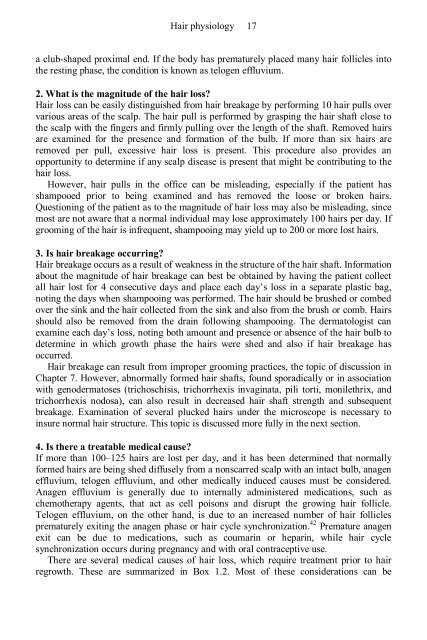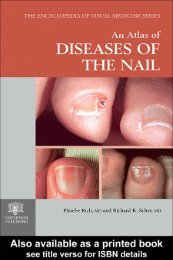You also want an ePaper? Increase the reach of your titles
YUMPU automatically turns print PDFs into web optimized ePapers that Google loves.
<strong>Hair</strong> physiology 17<br />
a club-shaped proximal end. If the body has prematurely placed many hair follicles into<br />
the resting phase, the condition is known as telogen effluvium.<br />
2. What is the magnitude of the hair loss?<br />
<strong>Hair</strong> loss can be easily distinguished from hair breakage by performing 10 hair pulls over<br />
various areas of the scalp. The hair pull is performed by grasping the hair shaft close to<br />
the scalp with the fingers and firmly pulling over the length of the shaft. Removed hairs<br />
are examined for the presence and formation of the bulb. If more than six hairs are<br />
removed per pull, excessive hair loss is present. This procedure also provides an<br />
opportunity to determine if any scalp disease is present that might be contributing to the<br />
hair loss.<br />
However, hair pulls in the office can be misleading, especially if the patient has<br />
shampooed prior to being examined and has removed the loose or broken hairs.<br />
Questioning of the patient as to the magnitude of hair loss may also be misleading, since<br />
most are not aware that a normal individual may lose approximately 100 hairs per day. If<br />
grooming of the hair is infrequent, shampooing may yield up to 200 or more lost hairs.<br />
3. Is hair breakage occurring?<br />
<strong>Hair</strong> breakage occurs as a result of weakness in the structure of the hair shaft. Information<br />
about the magnitude of hair breakage can best be obtained by having the patient collect<br />
all hair lost for 4 consecutive days and place each day’s loss in a separate plastic bag,<br />
noting the days when shampooing was performed. The hair should be brushed or combed<br />
over the sink and the hair collected from the sink and also from the brush or comb. <strong>Hair</strong>s<br />
should also be removed from the drain following shampooing. The dermatologist can<br />
examine each day’s loss, noting both amount and presence or absence of the hair bulb to<br />
determine in which growth phase the hairs were shed and also if hair breakage has<br />
occurred.<br />
<strong>Hair</strong> breakage can result from improper grooming practices, the topic of discussion in<br />
Chapter 7. However, abnormally formed hair shafts, found sporadically or in association<br />
with genodermatoses (trichoschisis, trichorrhexis invaginata, pili torti, monilethrix, and<br />
trichorrhexis nodosa), can also result in decreased hair shaft strength and subsequent<br />
breakage. Examination of several plucked hairs under the microscope is necessary to<br />
insure normal hair structure. This topic is discussed more fully in the next section.<br />
4. Is there a treatable medical cause?<br />
If more than 100–125 hairs are lost per day, and it has been determined that normally<br />
formed hairs are being shed diffusely from a nonscarred scalp with an intact bulb, anagen<br />
effluvium, telogen effluvium, and other medically induced causes must be considered.<br />
Anagen effluvium is generally due to internally administered medications, such as<br />
chemotherapy agents, that act as cell poisons and disrupt the growing hair follicle.<br />
Telogen effluvium, on the other hand, is due to an increased number of hair follicles<br />
prematurely exiting the anagen phase or hair cycle synchronization. 42 Premature anagen<br />
exit can be due to medications, such as coumarin or heparin, while hair cycle<br />
synchronization occurs during pregnancy and with oral contraceptive use.<br />
There are several medical causes of hair loss, which require treatment prior to hair<br />
regrowth. These are summarized in Box 1.2. Most of these considerations can be







